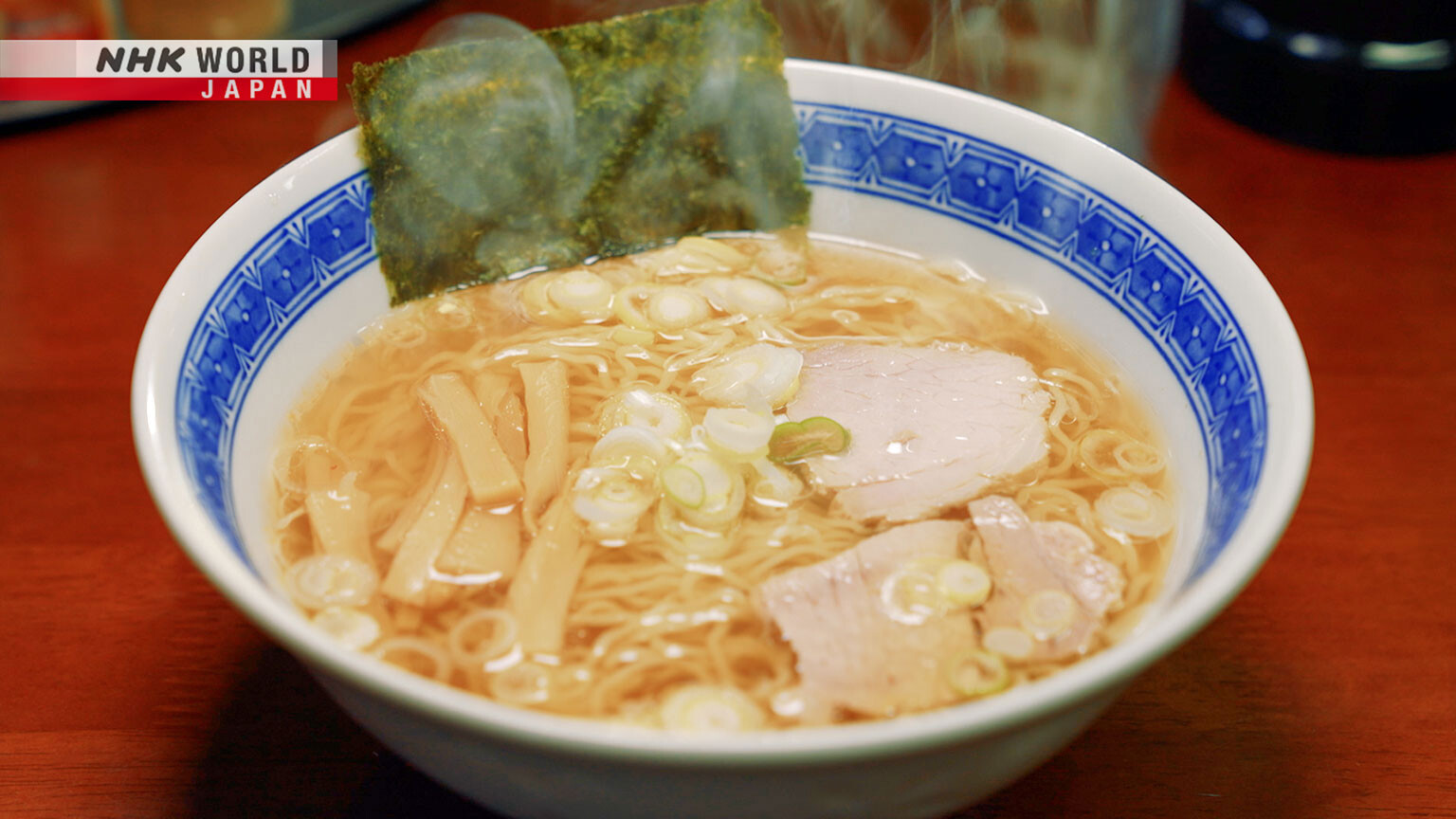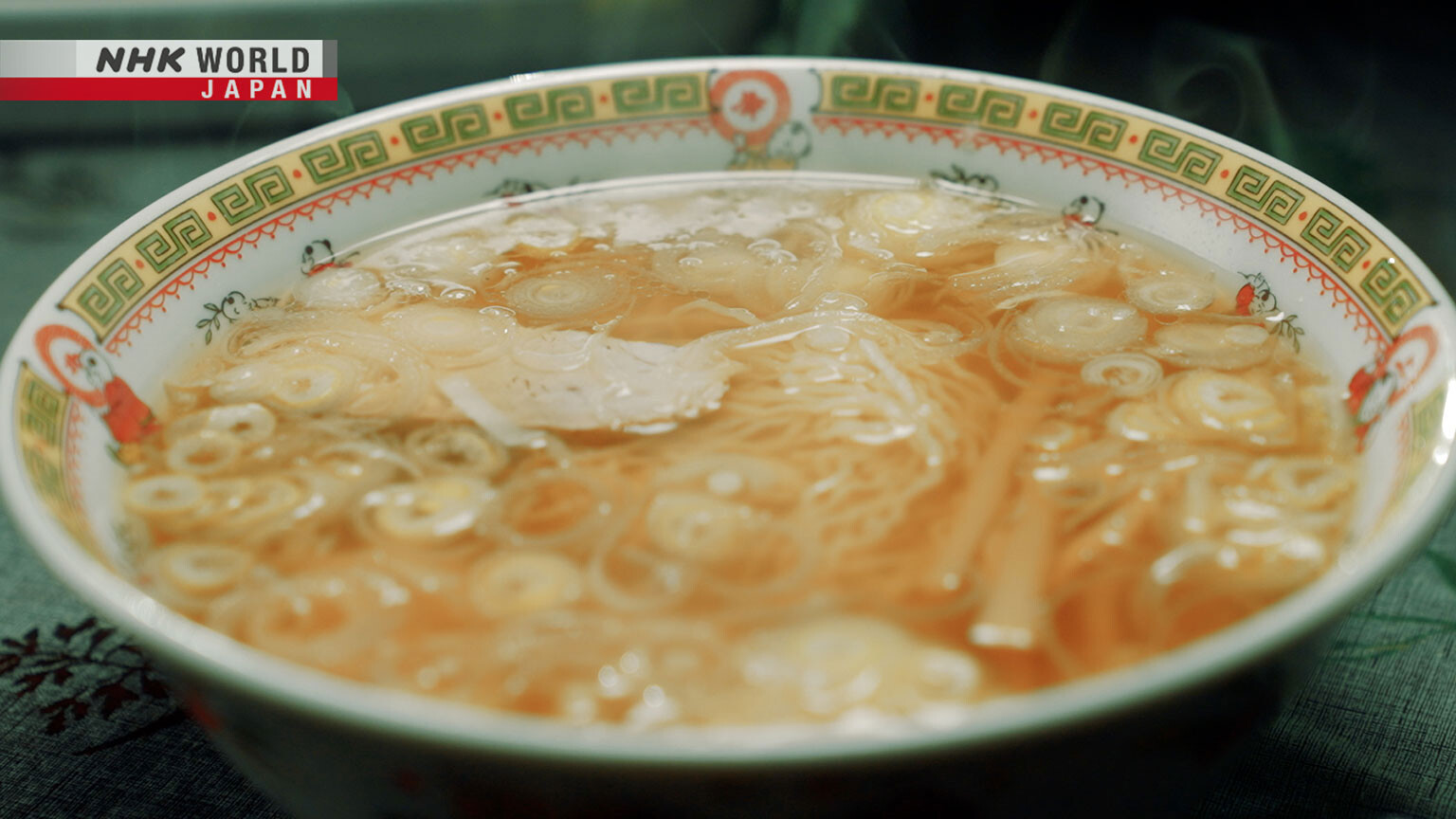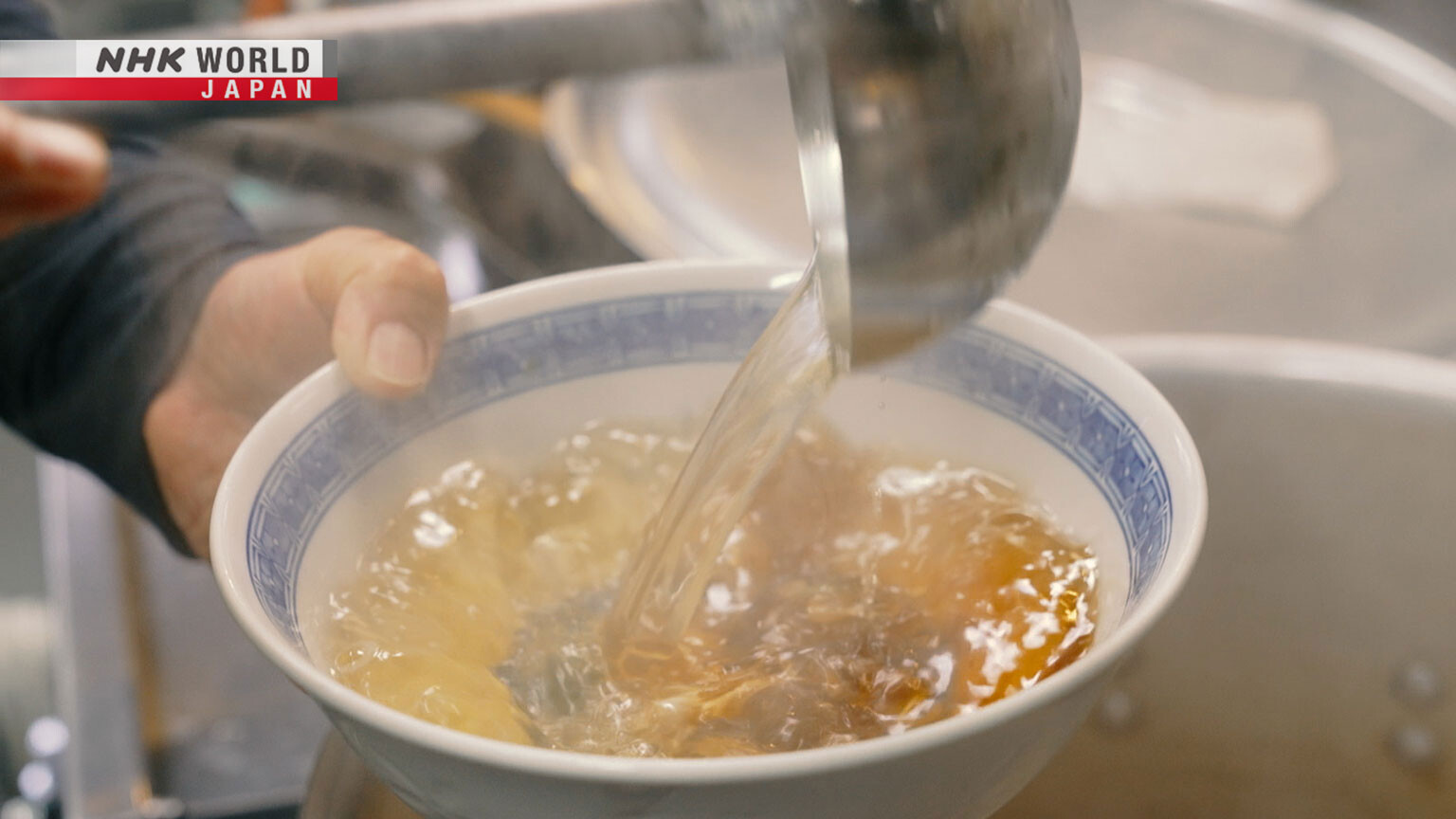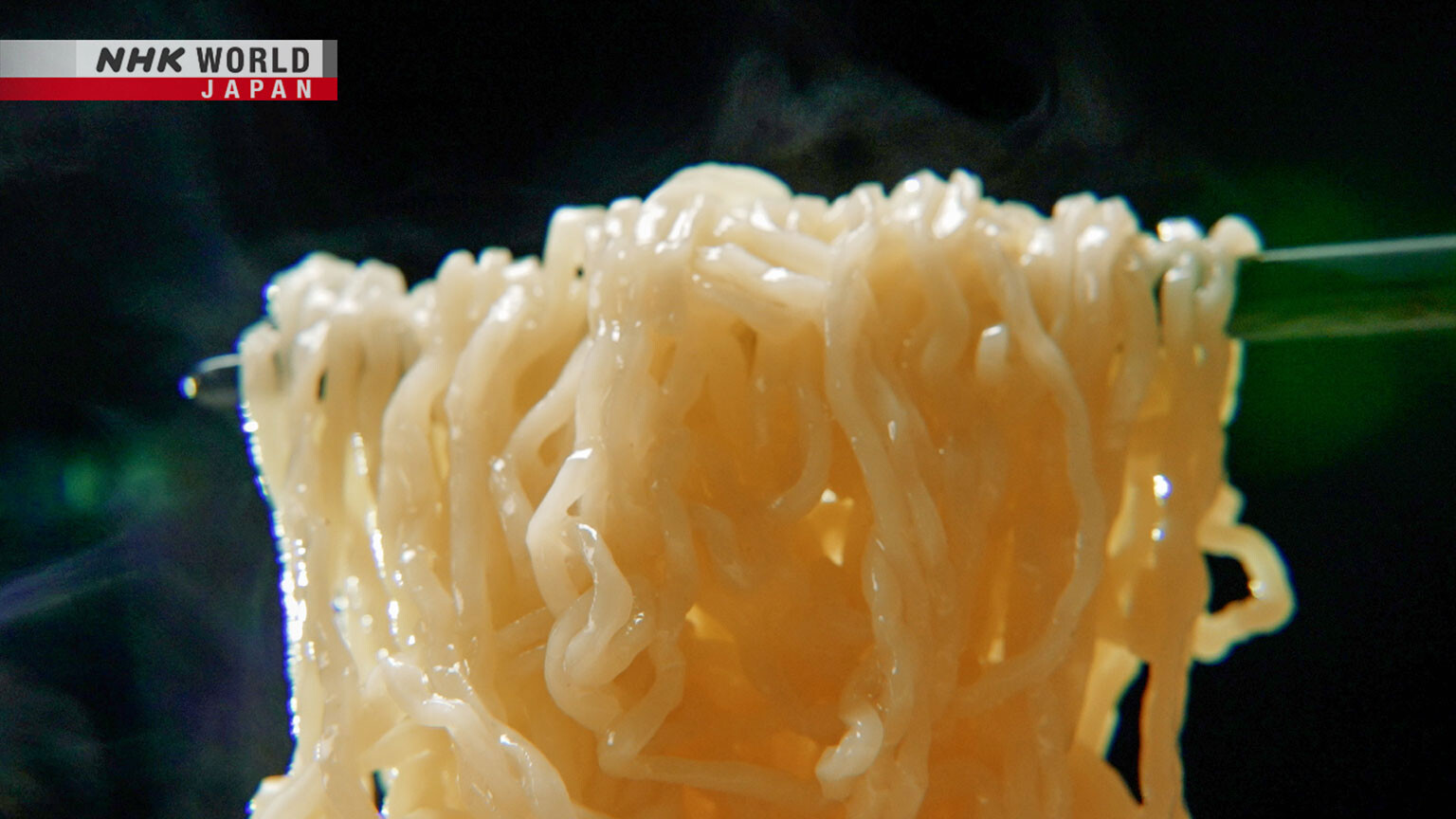KAMAISHI, IWATE
Ultra-thin noodles and amber broth: the story of a people who overcame disaster and their favorite bowl of ramen.




Transcript
Ramen Japan! This time in Kamaishi, Iwate Prefecture.
This is the story of the ramen that's stayed with the city through good times and bad.
I didn't know what to do... But I had to do something!
And in the end, it was ramen.
Kamaishi, Iwate has a population of around 30,000.
Nearby some of the world's most productive fishing grounds, this port town has a thriving fishing industry.
The city spreads out from the fishing port,
and it's where you'll find the ramen loved by people of all ages here in Kaimaishi!
The local ramen association has 33 member shops.
The association's vice president, Konno Tokio, explains what makes Kamaishi ramen so special.
First, there's the clear soy sauce-based soup.
At our shop it's pork bones, dried sardines, and vegetables.
Unlike Kyushu "tonkotsu" ramen, it's kept just below boiling, about 90℃.
This makes for a clear amber broth.
The noodles are also special. Extremely thin.
About 1 mm, quite fine.
Where I was born and raised, it's always been this way.
The soup's umami comes on slowly. Ramen is the best fast food.
It's light, but there's also a richness.
The first bite makes me instantly happy.
This Chinese restaurant is the birthplace of Kamaishi ramen.
It first opened in 1951.
Nothing beats these fine noodles.
Almost like thin Japanese "somen" noodles.
I can have as many bowls as I want.
Okay, want another one?
Saijo Nobuhito served up the first ever bowl of ramen in Kamaishi.
Now, his son, Masanobu, is the second-generation owner, and keeper of the flame.
Kamaishi ramen means ultra-fine noodles...
But when the shop first opened the noodles were much thicker.
Mom wanted "somen"-style thin noodles, so she asked dad to make finer ramen.
"Somen" noodles are made by stretching wheat flour dough into thin strands.
The national standard is under 1.3mm.
We made our own noodles, so he told her he could do it.
The characteristic ultra-fine ramen noodles came about from this simple request.
They measure just 1mm!
Cooking time is only 25 seconds.
With this, Kamaishi-style ramen was complete.
When the original owner, Nobuhito, was just 27,
the family moved to Kamaishi from a neighboring prefecture after hearing of its economic boom.
His son, Masanobu, still vividly remembers the first time he set eyes on his new home.
It was a real surprise.
Leaving the station, there were all these huge chimneys.
Looking up at them made me dizzy.
Kamaishi had long been a flourishing center for steel production, and the mills towered over it.
In the 1950s, the postwar reconstruction led to a period of significant economic growth.
And the steelworks in Kamaishi helped support it.
Rails for the Shinkansen bullet train and other construction materials were produced non-stop, 24 hours a day.
And the city's population grew to over 90,000.
The owner of this dining bar, Kikuchi Yuko, remembers the vibrant pace of life in those days.
It was a very lively place. The streets were too crowded to walk.
Ramen, still a rarity at the time, was something the workers who came from all over the country enjoyed.
Everyone said it back then.
"Kamaishi is the only place to get ramen," and It was true.
There was no ramen in the countryside, but you could get it here.
Ramen shop owner Konno Tokio used to work in the steel mills himself.
His father was also a steelworker.
When I was little we lived in company housing, and we'd have ramen delivered.
It was always a feast!
Gradually the number of shops serving ramen in Kamaishi grew.
When Konno was 29, he started selling ramen from a converted van.
The shop was open from 10 pm to 3 am. It became very popular.
But Kamaishi's economic boom didn't last long.
The steel industry was in decline by the mid-1970s, and blast furnaces were dismantled to scale down production.
The number of workers, which had been over 10,000 at its peak, gradually diminished.
The population dropped from nearly 100,000 to just 30,000.
For the ramen shops of Kamaishi, it was a major challenge.
Kamaishi's Chamber of Commerce and Industry is near the fishing port.
The ramen association searched for a way to help revitalize the declining city.
This is a ramen map they created at the time.
It lists all 43 of the local ramen shops.
With the map complete, the shop owners gathered to prepare a press release.
It was the evening of March 10th, 2011.
We discussed how to get the word out about our ramen. It was very positive.
We said, "We can do it! Let's do our best!" And then the next day, the Tsunami hit.
Saijo's shop was around 600m from the coast.
As the tsunami encroached, they evacuated to the roof.
The wave rushed in...
Cars stopped at traffic lights were washed away.
Even steel was carried away. It made an awful sound.
The tsunami in Kamaishi reached nearly 20m high.
The ground floor of Saijo's shop was completely flooded.
The refrigerator was torn off the wall. I had no idea what to do...
This clock hung on the kitchen wall at the time.
It stopped at just after 3:20pm. Probably right when the wave hit.
The tsunami hit everything here.
Of the 43 shops on the map, 25 were destroyed by the wave.
The worst of it occurred in the Unosumai area.
Half of the Kamaishi residents who lost their lives had homes here.
Dobashi Kazushi of the Chamber of Commerce and Industry was born and raised in Unosumai.
All the shops in Unosumai were washed away.
And two of the owners lost their lives.
This one was very popular, with dried sardine dashi.
Unosumai is where I'm from. I can still see their faces.
The missing and dead from Kamaishi totaled almost 1,000 souls.
Not long after the disaster, Saijo found something in the wreckage of his shopfront.
I saw the shop curtain in the debris. I was sure it had been washed away.
At that moment, the image of his father, the creator of Kamaishi ramen, came into his mind.
Dad was quiet, but he was scary when he got angry. That's the way he was.
It felt like a message from my father.
So, I knew we had to get to work.
More than six months after the disaster in November of 2011,
headed by Saijo, the Kamaishi Ramen Association was rebuilt with 23 member shops.
He also set out to rebuild his own shop, which had been damaged in the disaster.
At that point all we could do was wait, but we also had the joy of working.
Okay, this is the start of a new day!
Let's greet everyone with a smile.
9 months after the disaster, Saijo's shop reopened.
We became a community.
Customers found fellow survivors when they came in to eat.
I'm glad we decided to rebuild.
Present-day Kamaishi, Unosumai.
At the invitation of his friend, Konno's shop, which was also hit by the disaster, relocated here three years ago.
There wasn't a single shop here. That's why he asked me to come.
Ramen lovers from the area all came.
When it first opened, I remember how nostalgic it felt to eat here.
This man was born and raised in Unosumai.
Mom loved ramen. She'd always go someplace to get it after work.
His mother, one of the victims of the tsunami, was never found.
Just ask anybody from Kamaishi what food they love most.
They'll always say ramen.
Ramen really is the heart of Kamaishi.
People here always work hard.
Thirteen years have passed since the disaster.
The latest ramen map has been completed.
On it, all the current local ramen shops, now 33 members strong.
Kamaishi means ramen. It's my reason for living.
Wouldn't you like to try some yourself?
Come pay a visit for the best bowl of ramen you've ever had.